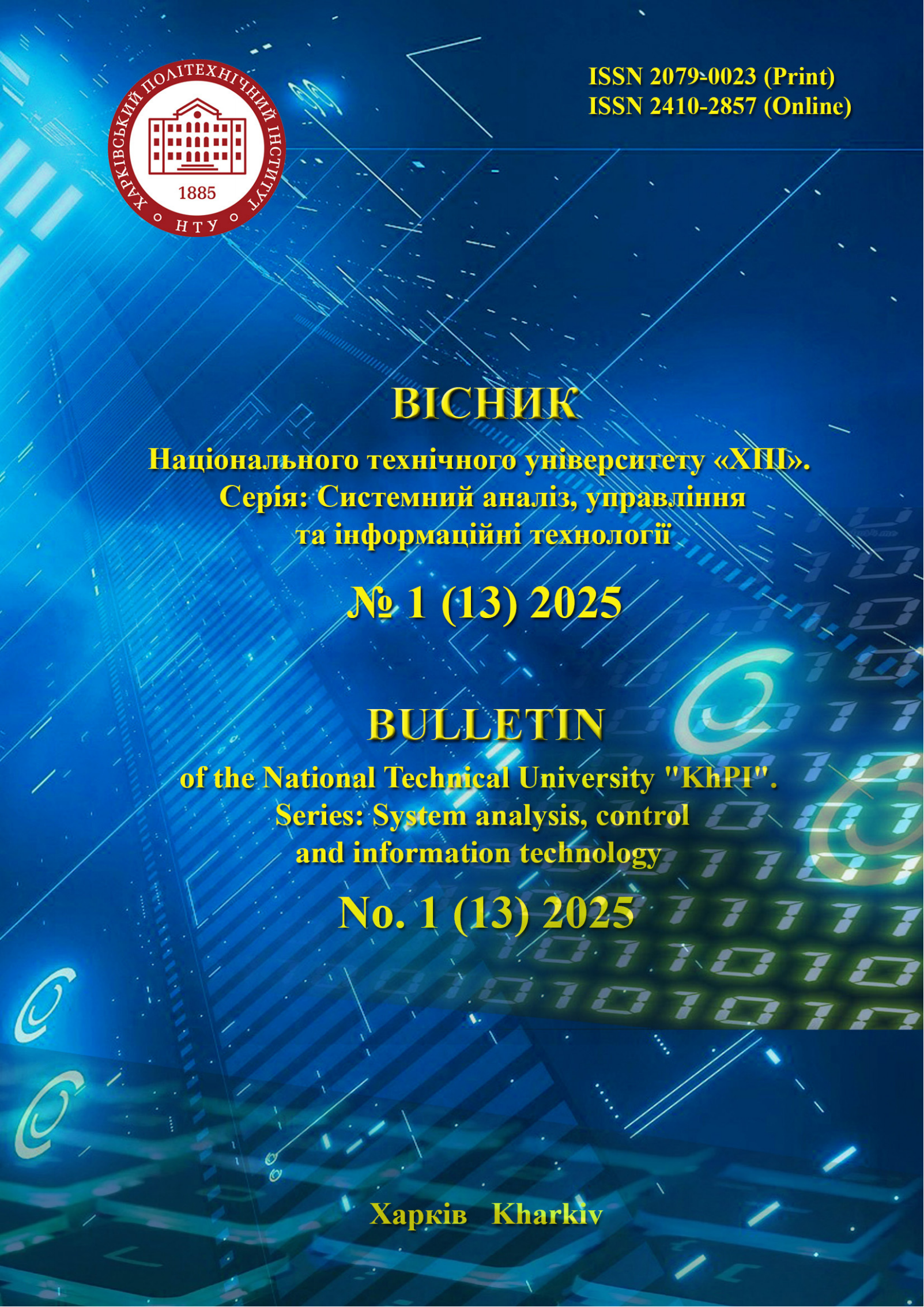CYBERSECURITY POLICY CONTROL SYSTEM WITH ELEMENTS OF ARTIFICIAL INTELLIGENCE OF THE CORPORATE COMMUNICATION NETWORK
DOI:
https://doi.org/10.20998/2079-0023.2025.01.02Keywords:
cybersecurity, threats, protection, corporate networks, artificial intelligence, Theil indexAbstract
In today’s digital world, where almost all aspects of life are connected to the Internet, cybersecurity is not just important but an integral part of our reality. It ensures the smooth operation of services: from email to social and corporate networks across all sectors of critical infrastructure in countries worldwide. The development of artificial intelligence in the field of cybersecurity opens up significant potential for improving the effectiveness of information protection in all sectors of critical infrastructure. The developed system relates to the cybersecurity policy with artificial intelligence elements for corporate communication networks. The goal is to improve the accuracy of forming and controlling the cybersecurity policy of corporate communication networks by identifying techniques for executing computer attacks using artificial intelligence and analyzing the situation and vulnerabilities present in the software infrastructure. To achieve this goal, a cybersecurity policy control system with artificial intelligence elements for corporate communication networks was developed. The effectiveness of the developed system was calculated by comparing Theil coefficients to assess its validity. The developed system processes and evaluates information using artificial intelligence, including comparator identification, which allows for understanding the capabilities and techniques of executing each known computer attack. It also uses a situational text predicate to identify and analyze the situation of a cyberattack and predict its trajectory, determining the likelihood of each known attack and comparing it with the effectiveness of existing defense measures. By comparing the calculated Theil coefficients of the system with an existing analogue, it was concluded that the validity of forming a cybersecurity policy with artificial intelligence elements in the developed system is higher than that of the analogue, confirming the achievement of the proposed technical result. The use of AI in corporate communication networks enables faster and more efficient detection, analysis, and response to cyber threats, providing a high level of protection against modern cyberattacks. The integration of AI into cybersecurity also enhances security and improves the ability to respond to the challenges of today’s digital environment. Thus, AI integration in the field of cybersecurity opens up new opportunities for ensuring effective and comprehensive protection against cyber threats in the modern digital world, becoming a key factor in ensuring future cybersecurity.
References
Orhanizatsiia kanalu peredachi danykh dlia biznesu. [Organization of data transmission channel for business]. GigaTrans Telecom operator. Available at https://gigatrans.ua/ua/services/organizaciya-kanala-peredachi-dannuh. (accessed: 20.01.2025).
DSTU ISO/IEC 27001:2023 Informatsiina bezpeka, kiberbezpeka ta zakhyst konfidentsiinosti. Systemy keruvannia informatsiinoiu bezpekoiu. Vymohy (ISO/IEC 27001:2022, IDT) [Information Security, cybersecurity and privacy protection. Information security management systems. Requirements] / National Standart of Ukraine. Кyiv: DP «UkrNDNC» Publ., 2022. 26 p.
Bezpeka. [Safety]. CityHost. Available at https://cityhost.ua/uk/blog/bezopasnost/2/. (accessed: 20.01.2025).
2024 SonicWall Cyber Threat Report. Marlin Communications. Available at https://marlincomms.co.uk/wp-content/uploads/2024/ 03/SonicWall-Marlin-Cybersecurity-Threat-Report-compressed.pdf. (accessed: 20.01.2025).
Hraivoronskyi M. V., Novikov O. M. Bezpeka informatsiino-komunikatsiinykh system [Security of information and communication systems]. Kyiv: BHV Publ., 2009. 608 p.
Kucherniuk P. V. Metody i tekhnolohii zakhystu komp’iuternykh merezh (fizychnyi ta kanalnyi rivni) [Methods and technologies for protecting computer networks (physical and channel levels)]. Mikrosystemy, Elektronika ta Akustyka [Microsystems, Electronics and Acoustics]. 2017. Vol. 22, Iss. 6(101). pp. 64–70.
Smelyakov K., Chupryna A., Darahan D., Midina S. Effectiveness of modern text recognition solutions and tools for common data sources. CEUR Workshop Proceedings, 2021, Vol. 2870, pp. 154–165.
Smelyakov K., Pribylnov D., Martovytskyi V., Chupryna A. Investigation of network infrastructure control parameters for effective intellectual analysis. 14th International Conference on Advanced Trends in Radioelecrtronics, Telecommunications and Computer Engineering (TCSET). Lviv-Slavske, Ukraine, 2018, pp. 983–986.
Bondarchuk O. I., Naumenko T. S., Tovt B. M. Rozrobka ta vprovadzhennia innovatsiinykh metodiv kiberbezpeky u komp’iuternykh systemakh. [Development and implementation of innovative cybersecurity methods in computer systems]. Tavriiskyi naukovyi visnyk. Seriia: Tekhnichni nauky [Tavria Scientific Bulletin. Series: Technical Sciences], 2024, Iss. 4, pp. 31–40.
Levterov A. I., Pliekhova H. A., Sharonova N. V., Neronov S. M. Systema kontroliu polityky kiberbezpeky z elementamy shtuchnoho intelektu korporatyvnoi merezhi zv’iazku [Cybersecurity policy control system with elements of artificial intelligence of a corporate communication network]. Patent UA, no.157855, 2024.
Hasan S. K. Computer security based on Artificial intelligence. Patent US, no. 2017/0214701 A1. 2017.
Bellù L. G., Liberati P. Describing Income Inequality. Theil Index and Entropy Class Indexes. Open Knowledge. Available at https://openknowledge.fao.org/ server/api/core/bitstreams/2d4181c9-30f3-4511-a1f8-f641ab0a13d8/content. (accessed 20.01.2025).
Downloads
Published
How to Cite
Issue
Section
License

This work is licensed under a Creative Commons Attribution 4.0 International License.
Authors who publish with this journal agree to the following terms:
- Authors retain copyright and grant the journal right of first publication with the work simultaneously licensed under a Creative Commons Attribution License that allows others to share the work with an acknowledgement of the work's authorship and initial publication in this journal.
- Authors are able to enter into separate, additional contractual arrangements for the non-exclusive distribution of the journal's published version of the work (e.g., post it to an institutional repository or publish it in a book), with an acknowledgement of its initial publication in this journal.
- Authors are permitted and encouraged to post their work online (e.g., in institutional repositories or on their website) prior to and during the submission process, as it can lead to productive exchanges, as well as earlier and greater citation of published work (See The Effect of Open Access).


